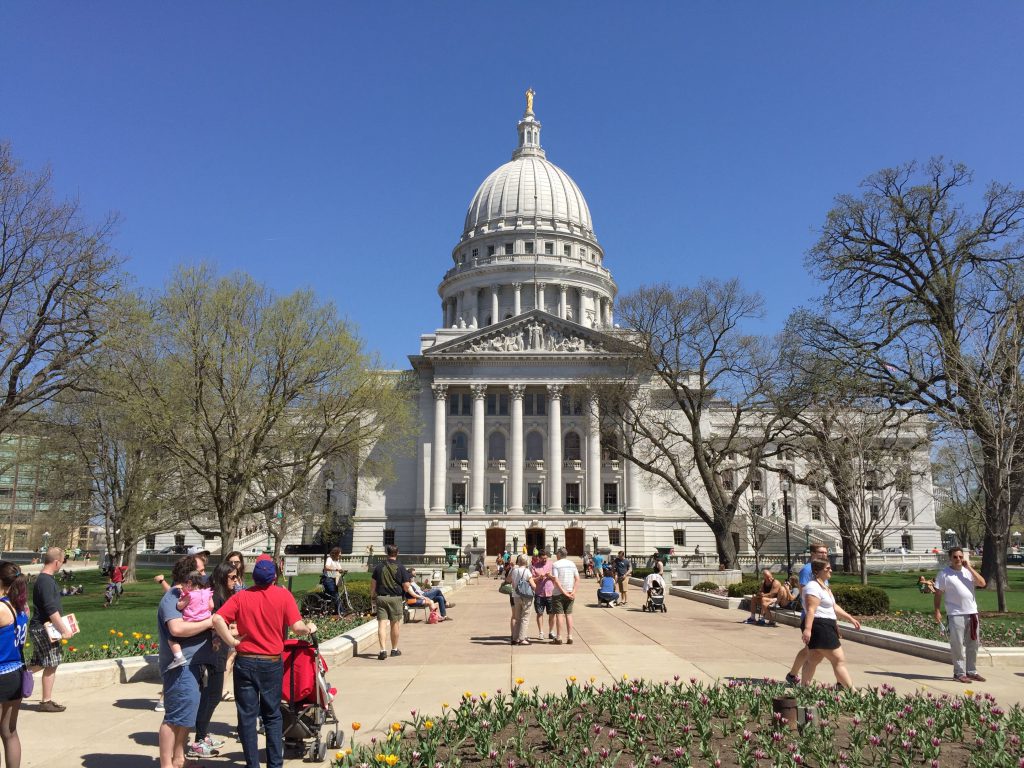8 Questions About State Government
Think you know how our state Capitol works? Try answering these questions.
If you’re stuck at that boring holiday party, here are some questions about state government you can ask between drinks. Guaranteed to stump that verbose know-it-all dominating the conversation.
Question 1: The federal government spent $4.62 trillion on COVID aid between 2020 and Oct. 1 of this year. How much of that went to Wisconsin?
Choices: A. $16.8 billion; B. $32.9 billion; C. $61.3 billion; D. $107.4 billion; E. $204.9 billion.
Answer: B. (The other amounts went to Iowa, $16.8 billion; Michigan, $61.3 billion; Illinois, $107.4 billion; and Minnesota, $204.9 billion.)
Question 2: A lawsuit was recently filed challenging Act 10, Republican Gov. Scott Walker’s 2011 signature law that abolished collective bargaining for most public employees and made them pay more for health care and pensions. Of the 132 current legislators, how many of them were in the Legislature and cast votes on Act 10?
Choices: A. 6; B. 21; C. 42; D. 57.
Answer: B. Twenty-one legislators – 15 Republicans and 6 six Democrats – were in office during the Act 10 controversy. Thirteen of the 21 are now state senators.
Question 3: As spending on campaigns for all Capitol offices – from governor to the Legislature to the Supreme Court – soars, what is the all-time record for total campaign spending for one seat in the Legislature?
Choices: A. $950,000; B. $2.3 million; C. $8.75 million; D. $9.99 million.
Answer: D. In the 2011 recall election in the 8th Senate District, which resulted from the Act 10 controversy, the two candidates — incumbent Republican Sen. Alberta Darling and Democratic Rep. Sandy Pasch — spent a total of $2.13 million and outside groups spent $7.86 million. Darling kept her Senate seat by winning that election. (Wisconsin legislators are paid $57,408 per year, not including expense stipends.)
Question 4: State government’s general fund is its checking account, so it’s watched closely for signs of how the state’s economy is doing and how much the governor and legislators can spend in the future. In the first four months of this budget year (July, August, September, October), what was the change in general-fund tax collections?
Choices: A. -5%; B. 0%; C. +7%; D. +15%.
Answer: B. The state Revenue Department reported July-through-October general fund tax collections of $5.6 billion – almost exactly what it was over the same period last year. Over those four months, personal income tax collections fell by 0.7%; sales taxes rose by 2.3% and corporate income taxes declined by 1.1%.
Question 5: When was the state tax on beer raised last, and by how much?
Choices: A. 1933; B. 1969; C. 1999: D. 2018.
Answer: B. Wisconsin’s tax on beer has only been increased once it was first enacted in 1933 at a rate of $1 on each 31-gallon barrel. In 1969, the tax was increased to $2 per barrel – about 6.5-cents per gallon. It’s been untouchable by Capitol politicians ever since. (Contrast that with the state cigarette tax – now $2.52 per pack – that has been raised nine times since 1980.)
Question 6: Of these four governors since 1950, which one came from the smallest Wisconsin community?
Choices: A. Republican Walter Kohler Jr. (1951-’57); B. Democrat Gaylord Nelson (1957-’59); C. Republican Warren Knowles (1965-’71); D. Republican Tommy Thompson (1987-2001).
Answer: D. Thompson came from Elroy, which has 1,343 residents. (Second was Kohler, born in the Village of Kohler, where his family-owned company is located; the village has a population of 2,192)
Question 7: Another question about governors. Democratic Gov. Tony Evers was 67 years old when he was sworn in as Wisconsin’s 46th governor in January 2019. How many other Wisconsin governors were older when they took office?
Choices: A. 2; B. 11; C. 19; D. 22.
Answer: A. Democrat Albert Schmedeman was 68 when he took office in January 1933; Republican Walter Goodland was 80 when he became governor in 1943. (Walker was just 43 when he became governor in January 2011.)
Question 8: Now that you’ve gotten used to navigating roundabouts – look out on your left! – cropping up on our streets and highways, how many of them are there in Wisconsin?
Choices: A. 77; B. 322; C. 554; D. 1,012
Answer: According to a September report in the Milwaukee Journal Sentinel, there are 554 roundabouts in Wisconsin – the most of any state. Of those, 287 are on state highways and 267 are on local roads.
For a state whose motto is “Forward,” that’s a lot.
Steven Walters started covering the Capitol in 1988. Contact him at stevenscotwalters@gmail.com
If you think stories like this are important, become a member of Urban Milwaukee and help support real, independent journalism. Plus you get some cool added benefits.
The State of Politics
-
RNC Brings Fame to Gen Z Party Leader
 Jul 15th, 2024 by Steven Walters
Jul 15th, 2024 by Steven Walters
-
Wisconsin’s Republican Roots Run Deep
 Jul 8th, 2024 by Steven Walters
Jul 8th, 2024 by Steven Walters
-
Feuding Supreme Court Justices Need a Break
 Jul 1st, 2024 by Steven Walters
Jul 1st, 2024 by Steven Walters






















Not buying the roundabout one… search up Roundabouts Database. Other states have more than us.
I would call this “8 Trivia About Wisconsin Government”. These are not “facts” about “Wisconsin government”.